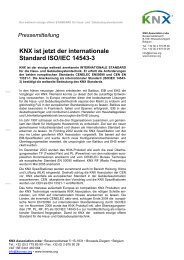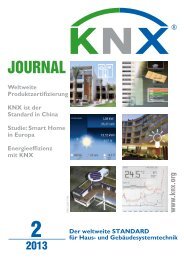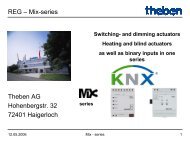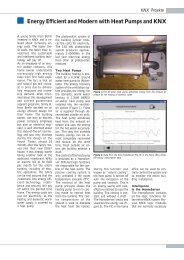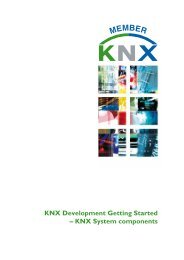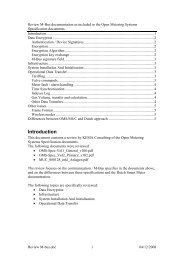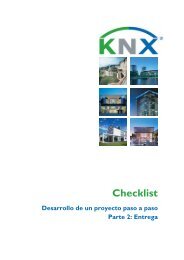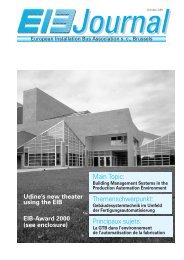KNX Journal 2011-1
KNX Journal 2011-1
KNX Journal 2011-1
Create successful ePaper yourself
Turn your PDF publications into a flip-book with our unique Google optimized e-Paper software.
<strong>KNX</strong> Projects<br />
Energy Management Inside<br />
First “Green Building” from INTEL equipped with <strong>KNX</strong><br />
INTEL Israel – The new development office in Haifa<br />
Since 2009, around 1000<br />
programmers and engineers<br />
have been working<br />
in the Israeli subsidiary<br />
of the US semiconductor<br />
manufacturer INTEL. The<br />
new development office in<br />
Haifa was built according<br />
to the LEED guidelines<br />
(Leadership in Energy and<br />
Environmental Design).<br />
INTEL has constructed a<br />
certified corporate “Green<br />
Building” for itself as well as<br />
the largest green building in<br />
the Middle East.<br />
Bound by strict standards<br />
but also living up to its<br />
image as a leading technology<br />
company, the planning<br />
office selected the <strong>KNX</strong><br />
control system for the building<br />
technology. It convinced<br />
the building engineers<br />
from INTEL with concrete<br />
arguments: the worldwide<br />
standardisation of <strong>KNX</strong>, the<br />
flexibility and functionality<br />
of the bus system for all<br />
trades as well as the versatile<br />
control possibilities for<br />
increased energy efficiency<br />
in buildings.<br />
In particular, efficiency at<br />
the workplace achieved<br />
through comfort and ease<br />
was required. This can be<br />
achieved with <strong>KNX</strong> through<br />
demand-based shading and<br />
air conditioning as well as<br />
optimal lighting conditions.<br />
The automatic control and<br />
regulation with <strong>KNX</strong> promises<br />
energy-saving operation<br />
for all trades, lighting,<br />
sun protection, heating,<br />
ventilation and air conditioning<br />
(HVAC).<br />
The programmability of the<br />
lighting and HVAC functions<br />
also enables a quick<br />
and economic change of<br />
use for the rooms – such as<br />
moving to the safe floors on<br />
the underground car park<br />
level in the extreme case of<br />
a war breaking out.<br />
Optimal lighting<br />
conditions<br />
The lighting systems for the<br />
offices, corridors and staircases,<br />
meeting rooms, conference<br />
rooms, WC facilities<br />
The largest green building in the Middle East<br />
and outdoor installations<br />
alone point to a high energy<br />
demand. If they are not switched<br />
on around the clock<br />
with 100 percent brightness<br />
but controlled automatically<br />
according to demand, it can be<br />
reduced by 10 to 50 percent.<br />
For this purpose, the planning<br />
office has introduced the<br />
combination of the <strong>KNX</strong> system<br />
with the digital addressable<br />
lighting interfaces (DALI)<br />
as an ideal solution. Together<br />
with the gateways (ABB <strong>KNX</strong><br />
DALI gateways), up to 64<br />
electronic ballast devices can<br />
be individually controlled and<br />
dimmed via <strong>KNX</strong> addresses.<br />
For the organisation of extensive<br />
lighting systems, up to 16<br />
control groups can be formed<br />
per gateway. This flexible method<br />
enables, in addition, the<br />
monitoring of each individual<br />
lamp for malfunctions – the<br />
benefit of an economic maintenance<br />
service.<br />
The perfect climate<br />
For personal requirements,<br />
employees can set the lighting<br />
level individually in lux at their<br />
workstation. A room-based<br />
operator interface is available<br />
on the company computers<br />
for the visualisation. To avoid<br />
unnecessary energy costs,<br />
presence detectors monitor<br />
the presence of people and<br />
switch lighting off automatically<br />
after an adjustable time<br />
delay in the event of absence.<br />
The lighting is also controlled<br />
and regulated in corridors, on<br />
staircases and in other rooms.<br />
Brightness sensors ensure<br />
a comfortable and constant<br />
brightness level. In the conference<br />
rooms which are used<br />
infrequently, the air conditioning<br />
system is controlled<br />
according to requirements<br />
via movement detectors. The<br />
lighting conditions can be adapted<br />
via scene controllers at<br />
the touch of a button.<br />
The energy management for<br />
the building technology is<br />
implemented via a <strong>KNX</strong> visualisation.<br />
A <strong>KNX</strong>/IP gateway<br />
creates the link to the OPC<br />
server. From the central location,<br />
the building functions<br />
can be monitored, influenced<br />
and optimised. The energy<br />
consumption can be monitored<br />
and analysed continuously<br />
and the discovered savings<br />
potentials that are discovered<br />
are utilised: an investment in<br />
the future which pays for itself<br />
in four to five years according<br />
to the calculations of the<br />
planners.<br />
The system integration of the<br />
<strong>KNX</strong> installation was carried<br />
out by the Israeli company<br />
S.Kahane&-Sohns LTD.<br />
Highlights at a glance<br />
• Largest building with “Green<br />
Building” certificate in the<br />
Middle East<br />
• 3160 <strong>KNX</strong> components<br />
• Installation costs of 200.000<br />
Euro<br />
Energy savings with <strong>KNX</strong><br />
• 4 to 5 year amortisation period<br />
through energy savings.<br />
12 <strong>Journal</strong> 1/<strong>2011</strong>




